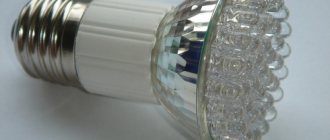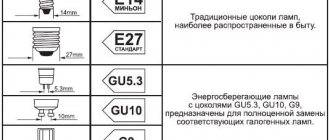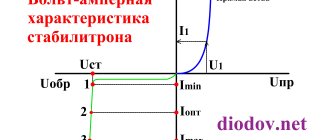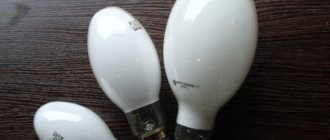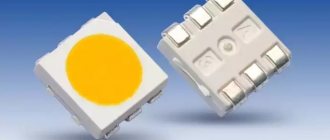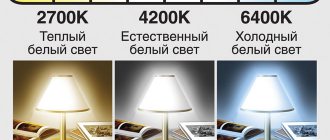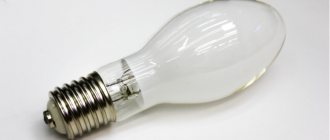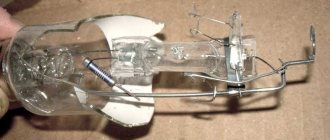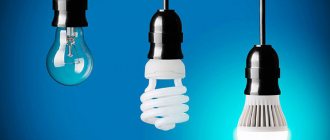The vast majority of people when buying an LED lamp pay attention to two parameters - price and brightness (luminous flux). In fact, there are a dozen more selection criteria that should be paid attention to.
Main selection criteria : manufacturer, luminous flux (brightness), power, supply voltage, color temperature, base type, dispersion angle, dimensions.
Additional criteria : dimming capability, operating temperature range, light flux pulsation.
Let's look at each item of technical specifications in detail.
Light flow
For most LED lamps, the luminous flux is 80-100 lm/W. There are LEDs based on COB technology, whose luminous flux reaches 180 lm/W, but they are not used in household products. In Chinese light bulbs, the normal brightness is 70-80 lm/W.
Comparative table of light output of different types of lamps
Detailed analysis: What is the luminous flux of diode lamps.
What are there
First you need to familiarize yourself with the types of lighting fixtures.
Standard
Most often, people buy standard varieties of light bulbs. They have a classic pear shape. The light output of such models is 70 lm/W.
RGB lamps
People who want to decorate their apartment in a non-standard way can purchase RGB models. Their main difference from other types of LED bulbs is that they can glow in any color.
Rechargeable
These are mobile devices that are used to illuminate a small area. They do not need to be connected to the mains, as they run on batteries.
LED lamps with remote control
Ice devices are considered convenient for use at home. They are controlled using a remote control, which sends a signal to the lamp using infrared radiation. The advantages include:
- build quality;
- efficiency;
- presence of a remote control.
Power
The power of an LED lamp is a derivative of the luminous flux, or vice versa. Please note that the LED parameters indicate the total power of the lamp and driver.
| Table of power and luminous flux ratio | |
| LED power, W | Luminous flux, Lm |
| 3-4 | 250-300 |
| 4-6 | 300-450 |
| 6-8 | 450-600 |
| 8-10 | 600-900 |
| 10-12 | 900-1100 |
| 12-14 | 1100-1250 |
| 14-16 | 1250-1400 |
Colorful temperature
Color temperature is a very important criterion when choosing LEDs.
Warm white light (2700-3200K). Warm light has a spectrum similar to that of an ordinary incandescent light bulb.
Neutral white light (3200-4500K). Bulbs with neutral white light are as close to daylight sunlight as possible. An ideal solution for illuminating the work area.
Cool white light (more than 4500K). These LED lamps have a white-blue glow. The best option for work spaces where increased concentration is required.
Detailed analysis: glow temperature of LED lamps.
Color rendering index
The characteristic, designated in the technical marking of led lamps as CRI, shows how naturally the color of objects is displayed, determined by a given light source. LED lamps are divided into 4 main groups:
- 100 – display as in full sunlight.
- Above 90 is the maximum possible color reproduction under artificial lighting.
- Above 80 is the standard brightness in domestic conditions.
- Below 80 is normal night lighting, when accuracy in color shades does not matter.
Base type
The most common type of base is E27. On the Internet, most of the technical specifications are for these LED lamps. This is the classic size of the base for ordinary incandescent light bulbs.
| Scheme | Designation | Purpose |
| E14 Minion | Traditional bases, the most popular in everyday life | |
| E27 Standard | ||
| E40 | Designed for high-power light bulbs. Lighting of large rooms or streets | |
| G4 | These sockets are used to completely replace halogen lamps with LEDs | |
| GU5.3 | ||
| GU10 | ||
| GX53 | Used in lamps (built-in or overhead) in furniture or ceilings | |
| G13 | Tubular swivel base used in T8 lamps |
Scattering angle
Manufacturers produce lamps of various shapes and sizes for the E27 base. Depending on the design and design features, the dispersion angle can be from 300 to 3200. Depending on the dispersion angle, the illuminated area also differs. This can be clearly understood from the figure below.
For general lighting, for example, a chandelier in the living room, a model with a maximum scattering angle is required, for a table lamp, on the contrary, with a minimum.
You can understand the approximate angle of dispersion of the light flux by looking at the form factor of the diode light bulb.
Manufacturers rating
The best manufacturers of LED lamps are the European companies Philips and Osram. Their offices are located in different parts of Europe and Asia, although their factories are located in China. However, this does not affect the quality of the products, and for many years the company has maintained a reputation as a reliable manufacturer.
The cost of the first starts from 500, the second - from 100 rubles.
The list below presents LED lamp manufacturers with the best price-quality ratio. There are both Russian and Asian manufacturers here:
- Feron is a domestic company engaged in the manufacture of LED products. The cost varies from 60 to 400 rubles;
- Camelion - based in Hong Kong, produces lamps with different bases (70–400 rubles);
- Jazzway is a Russian company that produces tubular and bulb diode lamps. There are more powerful and expensive products;
- Gauss is a domestic manufacturer. The model range includes cheap and expensive, but economical products.
Lamps are most often found in everyday life and industry. A few years ago it was clear that the future belonged to LED lamps. They are more efficient than conventional and energy-saving ones, and emit less harmful light. Companies all over the world are engaged in production, so it is possible to choose electrical products that are most suitable in shape, power and other parameters.
Operating temperature range
By default, the normal operating temperature of LEDs is from -30C0 to +60C0. In some regions, outdoor temperatures during winter may fall below these limits.
It is also not recommended to install such lamps in rooms with high temperatures, for example, a sauna steam room, or near powerful heat sources.
Working in extreme temperatures
For LEDs, the upper limit of ambient temperature corresponds to a 30% drop in luminous flux.
The operation of LED lamps at low temperatures significantly reduces the heating of the semiconductor crystal, which increases its uninterrupted operation time.
Illumination standards
There are lighting standards for each room.
Bedroom, kitchen
Any apartment has a bedroom and a kitchen, which should be well lit. If these rooms are too large, you will have to install 2-3 lamps. They will provide lighting at a level of 150-200 Lux.
Children's room
People with children have a children's room in their apartment. Most often, these rooms are smaller than bedrooms and therefore do not need to be illuminated with bright lamps.
Bathroom, toilet
A toilet and a bathroom are the smallest rooms in the apartment. Even weak LED bulbs are suitable for lighting them, providing an illumination of 45-50 Lux.
General office
Office spaces are very large, and therefore powerful lighting fixtures are installed in them. The optimal illumination for an office is 250 Lux.
Drawing office
The brightest light is needed for offices intended for drawing work. Their illumination level should be at least 400 Lux.
Actual parameters of LED lamps
The table below shows the results of testing twenty-six LED light bulbs from various manufacturers. For famous brands Osram and Philips, passport data always corresponds to real parameters. For others, the luminous flux of the product may be a quarter lower than the declared parameters.
Table of correspondence between denominations of different manufacturers
Pay attention to the bottom position. Bellight LEDs produced in Poland have significant discrepancies in their design parameters. Such diodes are definitely not worth buying. Not only will you pay twice as much for “virtual” lumens, but with such a pulsation coefficient, installing them in residential areas is hazardous to health.
For clarity, we present data from testing Chinese light bulbs.
Features of LED light
A light-emitting diode is a semiconductor device that produces a glow when electric current passes through it. The light that such a diode is capable of emitting is located in a fairly narrow spectral range. In this case, the color itself will depend on the material from which the LED semiconductor is made. The formation of white color in such products is achieved in the following ways:
- combining diodes of different glow colors to produce white light. This method allows you to obtain excellent color quality with the ability to adjust it. But this method is quite expensive, which affects the price of products that are not available to everyone;
- the use of phosphors to coat diodes. This is a fairly cheap and beneficial method that allows you to achieve a higher color rendering coefficient. But here, due to the applied phosphor coating, the luminous efficiency decreases.
Lamp structure
An LED light bulb consists of several diodes or, as they are sometimes called, chips. In addition, there is a driver, which is a device that converts alternating current with a voltage of 220 volts into the direct current necessary to power the diodes. Thanks to this structure, these light sources create a directional luminous flux, which is characterized by the directional angle for the generated glow.
conclusions
For all its attractiveness, buying an LED lamp has many pitfalls.
Purchasing products from world-famous brands eliminates the occurrence of “surprises” during operation. Only such a lamp will cost 2-3 times more expensive. The most famous LED manufacturers are Philips, Osram, Bosh, Ikea.
The middle price range, when price reductions do not affect quality, includes the following manufacturers: Jazzway, Feron, Navigator, Unitel, Lexman, Wolta. Among their assortment, there are not entirely successful models, but mostly they encounter small discrepancies between the real and the rated light flux.
Super budget LED . From time to time, very inexpensive LED lamps mainly of Chinese origin appear on the market. These products are guaranteed to have an increased luminous flux and contain the simplest current stabilizers. The lifespan of such paws is not much longer than energy-saving ones.
Please rate the article. We tried our best:)
Did you like the article? Tell us about her! You will help us a lot :)
Main characteristics
Following the proverb: “You are greeted by your clothes...” it is enough to pick up a box with a light bulb to get acquainted with its main technical characteristics. You should pay attention not to the large bright numbers, but to the description printed in small print with 10 or more items.
Light flow
At a time when the incandescent lamp was the No. 1 light source, the concept of luminous flux was of little interest to anyone. The brightness of the glow was determined by the rated power of the light bulb. With the advent of LEDs, the power consumption of light sources has decreased significantly, and the efficiency has increased. Due to this, savings appeared, which commercials so often remind us of.
Luminous flux (F, lm or lm) is a value that indicates the amount of light energy given off by a lighting device. Based on the luminous flux value, you can easily select a replacement for an existing bulb with a spiral. To do this, you can use the correspondence table below.
Along with luminous flux, you can often come across the concept of “luminous efficiency”. It is defined as the ratio of luminous flux to power consumption and is measured in lm/W. This characteristic more fully reflects the efficiency of the radiation source. For example, a 10 W LED neutral light lamp emits a luminous flux of approximately 900-950 lm. This means that its light output will be 90-95 lm/W. This is approximately 7.5 times more than an analogue with a 75 W coil with the same luminous flux.
It happens that after replacing an incandescent lamp with an LED, its brightness turns out to be lower than declared. The first reason for this phenomenon is the installation of cheap Chinese LEDs. The second is reduced power consumption. Both of these reasons indicate a low quality product.
Also, the amount of luminous flux depends on the color temperature. In the case of LEDs, it is customary to indicate the luminous flux for neutral light (4500°K). The higher the color temperature, the greater the luminous flux and vice versa. The difference in light output between the same type of warm (2700°K) and cold (5300°K) LED lamps can reach 20%.
Power
Power consumption of an LED lamp (P, W) is the second most important technical characteristic, which shows how much electricity the LED lamp consumes in 1 hour. The total energy consumption consists of the power of the LEDs and the power of the driver. The most in demand nowadays are LED lighting devices with a power of 5-13 W, which corresponds to 40-100 watt filament lamps.
High-quality pulse-type drivers consume no more than 10% of the total power.
As advertising, manufacturers often use the concept of “Equivalent power”, which is expressed in the inscription on the packaging like 10 W = 75 W. This means that a 10 W LED lamp can be screwed in instead of a regular 75 W bulb without losing any brightness. A difference of 7-8 times can be trusted. But if there is an inscription on the box like 6 W = 60 W, then often this is nothing more than an advertising gimmick designed for the average buyer. This does not mean that the product is of poor quality, but the actual light output will most likely be the same as an incandescent lamp, not 60, but much less.
Supply voltage and frequency
The supply voltage (U, V) is usually indicated on the box as a range within which the manufacturer guarantees normal operation of the product. For example, parameter 176–264V indicates that the light bulb will confidently cope with any changes in mains voltage without a significant loss of brightness.
Typically, an LED lamp with a built-in current driver has a wide range of input voltages.
If the power source does not contain a high-quality stabilizer, then voltage drops in the power supply will greatly affect the light output and affect the quality of lighting. In Russia, the most common are LED lamps powered by 230V AC mains with a frequency of 50/60 Hz and 12V DC mains.
Base type
You need to know the size of the base in order to select a light bulb in accordance with the existing socket in the lamp. The bulk of LED lamps are produced with threaded sockets E14 and E27, which are the standard for Soviet-style wall, table and ceiling lamps. It is not uncommon to see LED lamps with GU4, GU5.3 bases, which have replaced halogen lamps installed in spotlights and Chinese chandeliers with a remote control.
Colorful temperature
Color temperature (TC, °K) indicates the hue of the emitted light. In relation to white LED lamps, the entire scale is conventionally divided into three parts: with warm, neutral and cold light. When choosing, you should take into account that warm tones (2700-3500°K) soothe and make you feel comfortable, while cold tones (from 5300°K) invigorate and excite the nervous system.
In this regard, it is recommended to use a warm glow for the home, and a neutral glow in the kitchen, bathroom and work. LED luminaires with TC≥5300°K are only suitable for specific work and as emergency lighting.
Scattering angle
By the scattering angle one can judge the distribution of the light flux in space. This indicator depends on the design of the diffuser and the location of the LEDs. The norm for modern widely used lamps is a value of ≥210°. To effectively work with small details, it is better to buy a lamp with a scattering angle of 120° and install it in a table lamp.
Dimmable
The ability to dim (control the brightness of lighting) of an LED lamp implies its correct operation from a dimmer switch. Dimmable lamps are more expensive because their electronic unit is more complex. A regular LED light bulb, when connected to a dimmer, will not work or will blink.
Ripple factor
The pulsation coefficient (Kp) is not always given in the list of characteristics, despite the fact that it is of paramount importance and has an impact on health. The need to measure this parameter arose due to the presence of an electronic unit in the lamp and the high response of LEDs. Low-quality power supplies are not able to perfectly smooth out the ripple of the output signal, as a result of which the LEDs begin to flicker at some frequency.
The ripple factor of LED lamps powered by a stable DC network is zero.
LED lamps with a coefficient below 20% are considered to be of the highest quality. In models with a current driver, the ripple factor does not exceed 1%. It is easy to determine this parameter in practice using an oscilloscope. To do this, you need to measure the amplitude of the variable component of the signal on the LEDs and divide it by the voltage measured at the output of the power supply.
By the frequency of the alternating signal in the load, you can determine the type of driver used.
Operating temperature range
You should pay close attention to this characteristic if you intend to operate the LED light bulb in non-standard conditions: on the street, in production workshops. Some models are able to work correctly only in a narrow temperature range.
Color rendering index
Using the color rendering index (CRI or Ra), you can evaluate how natural the color of objects illuminated by an LED lamp is. Ra≥70 is considered good.
Degree of protection against moisture and dust
This parameter is expressed as IPXX, where XX are two digits indicating the degree of protection against solid objects and water. It may not be found in the list of characteristics if the lamp is intended exclusively for indoor use.
